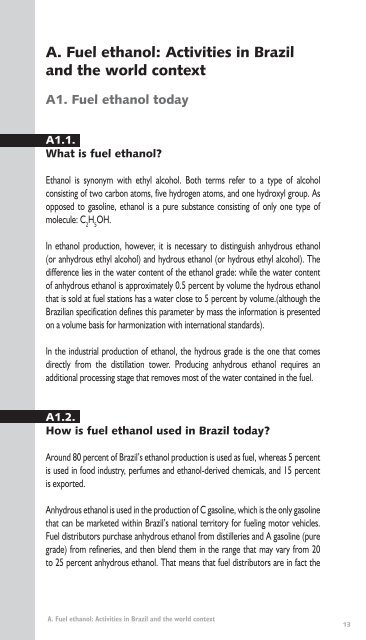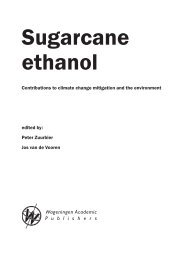Production and use of fuel ethanol in Brazil - BAFF
Production and use of fuel ethanol in Brazil - BAFF
Production and use of fuel ethanol in Brazil - BAFF
You also want an ePaper? Increase the reach of your titles
YUMPU automatically turns print PDFs into web optimized ePapers that Google loves.
A. Fuel <strong>ethanol</strong>: Activities <strong>in</strong> <strong>Brazil</strong><br />
<strong>and</strong> the world context<br />
A1. Fuel <strong>ethanol</strong> today<br />
A1.1.<br />
What is <strong>fuel</strong> <strong>ethanol</strong>?<br />
Ethanol is synonym with ethyl alcohol. Both terms refer to a type <strong>of</strong> alcohol<br />
consist<strong>in</strong>g <strong>of</strong> two carbon atoms, five hydrogen atoms, <strong>and</strong> one hydroxyl group. As<br />
opposed to gasol<strong>in</strong>e, <strong>ethanol</strong> is a pure substance consist<strong>in</strong>g <strong>of</strong> only one type <strong>of</strong><br />
molecule: C 2 H 5 OH.<br />
In <strong>ethanol</strong> production, however, it is necessary to dist<strong>in</strong>guish anhydrous <strong>ethanol</strong><br />
(or anhydrous ethyl alcohol) <strong>and</strong> hydrous <strong>ethanol</strong> (or hydrous ethyl alcohol). The<br />
difference lies <strong>in</strong> the water content <strong>of</strong> the <strong>ethanol</strong> grade: while the water content<br />
<strong>of</strong> anhydrous <strong>ethanol</strong> is approximately 0.5 percent by volume the hydrous <strong>ethanol</strong><br />
that is sold at <strong>fuel</strong> stations has a water close to 5 percent by volume.(although the<br />
<strong>Brazil</strong>ian specification def<strong>in</strong>es this parameter by mass the <strong>in</strong>formation is presented<br />
on a volume basis for harmonization with <strong>in</strong>ternational st<strong>and</strong>ards).<br />
In the <strong>in</strong>dustrial production <strong>of</strong> <strong>ethanol</strong>, the hydrous grade is the one that comes<br />
directly from the distillation tower. Produc<strong>in</strong>g anhydrous <strong>ethanol</strong> requires an<br />
additional process<strong>in</strong>g stage that removes most <strong>of</strong> the water conta<strong>in</strong>ed <strong>in</strong> the <strong>fuel</strong>.<br />
A1.2.<br />
How is <strong>fuel</strong> <strong>ethanol</strong> <strong>use</strong>d <strong>in</strong> <strong>Brazil</strong> today?<br />
Around 80 percent <strong>of</strong> <strong>Brazil</strong>’s <strong>ethanol</strong> production is <strong>use</strong>d as <strong>fuel</strong>, whereas 5 percent<br />
is <strong>use</strong>d <strong>in</strong> food <strong>in</strong>dustry, perfumes <strong>and</strong> <strong>ethanol</strong>-derived chemicals, <strong>and</strong> 15 percent<br />
is exported.<br />
Anhydrous <strong>ethanol</strong> is <strong>use</strong>d <strong>in</strong> the production <strong>of</strong> C gasol<strong>in</strong>e, which is the only gasol<strong>in</strong>e<br />
that can be marketed with<strong>in</strong> <strong>Brazil</strong>’s national territory for <strong>fuel</strong><strong>in</strong>g motor vehicles.<br />
Fuel distributors purchase anhydrous <strong>ethanol</strong> from distilleries <strong>and</strong> A gasol<strong>in</strong>e (pure<br />
grade) from ref<strong>in</strong>eries, <strong>and</strong> then blend them <strong>in</strong> the range that may vary from 20<br />
to 25 percent anhydrous <strong>ethanol</strong>. That means that <strong>fuel</strong> distributors are <strong>in</strong> fact the<br />
A. Fuel <strong>ethanol</strong>: Activities <strong>in</strong> <strong>Brazil</strong> <strong>and</strong> the world context<br />
13












